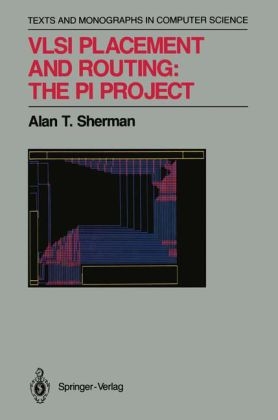
VLSI Placement and Routing
Springer-Verlag New York Inc.
978-0-387-97077-6 (ISBN)
- Titel ist leider vergriffen;
keine Neuauflage - Artikel merken
1 Introduction.- 1.1 How PI Lays Out a Chip: An Example.- 2 Preliminaries.- 2.1 Specifications for the PI System.- 2.2 Terminology.- 3 The Placement Framework.- 3.1 Overview of PI’s Placement Heuristics.- 3.2 PI’s Placement Problem.- 3.3 The Placement Tree.- 3.4 How PI Refines the Placement Tree.- 4 Chip Estimation and Pad Placement.- 4.1 Estimating Chip Size and Shape.- 4.2 Pad Placement.- 5 Logic Placement.- 5.1 Top-Down Mincut Partitioning.- 5.2 Module Orientation.- 5.3 Bottom-Up Hardening.- 5.4 Additional Placement Heuristics.- 5.5 Open Placement Problems.- 6 Power-Ground Routing.- 6.1 Overview of Power-Ground Routing.- 6.2 The Hamiltonian Circuit Heuristic.- 6.3 Calculating Current Requirements.- 7 Signal Routing.- 7.1 Overview of Signal Routing.- 7.2 Channel Definition.- 7.3 Global Routing.- 7.4 Crossing Placement.- 7.5 Channel Routing.- 8 Resizing.- 8.1 Overview of Resizing.- 8.2 Gathering the Constraints.- 8.3 Solving the Constraint Graphs.- 8.4 How PI Converges on a Solution.- 9 The MIT Implementation of PI.- 9.1 Objectives.- 9.2 Major Design Decisions.- 9.3 Critique.- 9.4 Source Code, Contributors, and Documentation.- 10 Related Layout Systems.- 10.1 2PI at General Electric.- 10.2 EC-PI at the Technion.- 10.3 Selected Other Layout Systems.- 11 Conclusion.- Basic Sources.- Mathematics and Computer Science.- VLSI Theory.- Placement.- Routing.- Compaction.- The PI System.- Other Placement and Routing Systems.- Layouts of Specific Circuits.- Other Works.
| Verlagsort | New York, NY |
|---|---|
| Sprache | englisch |
| Themenwelt | Mathematik / Informatik ► Informatik ► Betriebssysteme / Server |
| Mathematik / Informatik ► Informatik ► Programmiersprachen / -werkzeuge | |
| Mathematik / Informatik ► Informatik ► Theorie / Studium | |
| ISBN-10 | 0-387-97077-0 / 0387970770 |
| ISBN-13 | 978-0-387-97077-6 / 9780387970776 |
| Zustand | Neuware |
| Haben Sie eine Frage zum Produkt? |
aus dem Bereich


